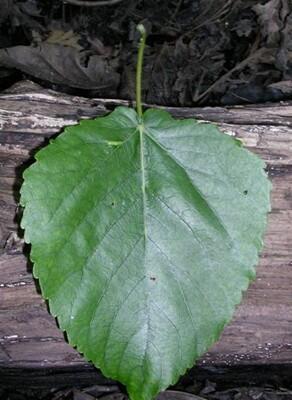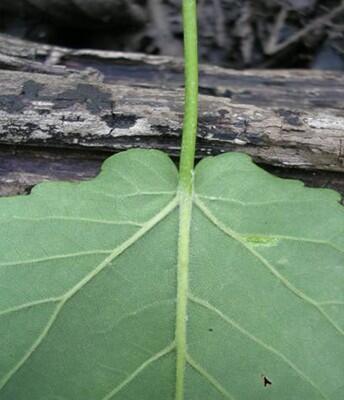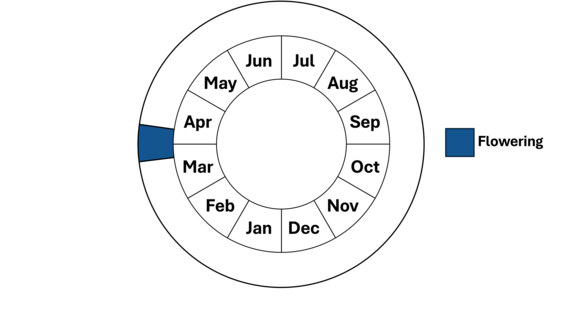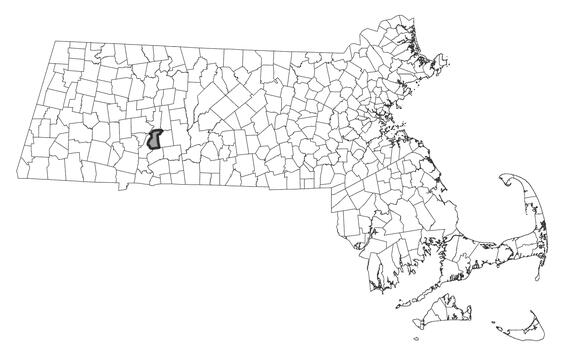- Scientific name: Populus heterophylla
- Species of Greatest Conservation Need (MA State Wildlife Action Plan)
- Endangered (MA Endangered Species Act)
Description

Swamp cottonwood trees in their swamp habitat. Photo by Karen Searcy.
Swamp cottonwood (family Salicaceae) is a shade-intolerant obligate wetland tree with deeply furrowed bark and large, alternate leaves, found in swamps and along borders of streams and rivers. It is uncommon throughout most of its range. In New York and New England, swamp cottonwood can be 8-15 m (~26–49 ft) tall and up to 36 cm (1.2 ft) in diameter, but in other parts of its range it grows to 30 m (~98 ft) tall and 90 cm (3 ft) in diameter. The ovate leaves are large (8-25 cm; 3.1-10 in × 7-18 cm; 2.6-7 in), with a rounded or acute tip and a cordate (heart-shaped) to occasionally almost sagittate (arrow-shaped) leaf base. The leaf margins are crenate (scalloped) to crenate-serrate with 30 to 60 shallow (0.3-1 mm; 0.012-0.04 in), irregularly spaced, incurved teeth on each side. When first produced in the spring, the leaves are cottony. At maturity the upper surface of the leaf is dark green and glabrous. The lower surface is pale green, and at maturity retains hairs near the petiole and on the mid-vein. The leaves produced directly from the winter bud and those produced during the summer are similar. The petioles, 4-8 cm (1.6-3.1 in) long, are round at least where they join the leaf blade, and may have up to two associated basilaminar glands (glands produced on the leaf blade near the petiole on the upper surface of the leaf). The winter buds are pubescent, reddish brown, and may be slightly resinous. The terminal bud is about 4-7 mm (0.16-0.28 in) long. The leaf shape and large size, the round petiole, and the pubescence pattern on the underside of the mature leaf are distinctive. Habitat is also useful since swamp cottonwood is only found in wetlands.
In Massachusetts, swamp cottonwood might be confused with eastern cottonwood (P. deltoides), with root suckers of big-toothed aspen (P. grandidentata), and with Populus × jackii (the hybrid between balsam poplar and eastern cottonwood). Swamp cottonwood can be distinguished from eastern cottonwood and big-toothed aspen by examination of petiole morphology; both of the more common species have flat, rather than round petioles. Populus × jackii, which has round petioles, has wedge-shaped to only very shallowly cordate leaf bases, which differs from the markedly cordate leaf base of swamp cottonwood. Leaves of Populus × jackii are also stained with reddish resin, not found in swamp cottonwood. Hybrids of swamp cottonwood and eastern cottonwood have been found in some wet disturbed areas such as drainage ditches.

The upper surface of a mature leaf with a shiny, glaucous surface, heart-shaped leave base, and teeth along the leaf margins.

The paler underside of the leaf with retained hairs near the petiole. Photos by Karen Searcy.
Life cycle and behavior
Swamp cottonwood is dioecious, with male and female catkins produced on different trees. Flowering occurs in late March to April before the leaves emerge. Swamp cottonwood is also capable of extensive vegetative reproduction by sprouts or suckers from the root system.

Population status
Swamp cottonwood is listed as endangered under the Massachusetts Endangered Species Act. All listed species are protected from killing, collecting, possessing, or sale and from activities that would destroy habitat and thus directly or indirectly cause mortality or disrupt critical behaviors. The Natural Heritage & Endangered Species Program has 1 record from 1 county: Hampshire. This record has been observed within the last 25 years.

Distribution in Massachusetts. 1999-2024. Based on records in the Natural Heritage Database.
Distribution and abundance
Swamp cottonwood has a coastal plain distribution and occurs along the Atlantic seaboard from Southern New England to the Florida panhandle, along the gulf coast to Louisiana and in the Mississippi River Basin to Illinois, Ohio, and Southern Michigan. It is also found in Ontario, Canada.
Habitat
Swamp cottonwood is known from only a single site in Massachusetts: a seasonally flooded depression with mucky soil that receives run-off from an adjacent basalt ridge. In wet years, the depression retains water all summer. Associated species include buttonbush (Cephalanthus occidentalis), winterberry (Ilex verticillata), silky dogwood (Swida amomum), silver maple (Acer saccharinum), green ash (Fraxinus pennsylvanica), and pin oak (Quercus palustris).
Healthy habitats are vital for supporting native wildlife and plants. Explore habitats and learn about conservation and restoration in Massachusetts.
Threats
Threats to the population include competition from other native woody species and exotic invasive species that grow around the margin of the depression. The population shows evidence of extensive vegetative reproduction and may be a single clone. If so, the potential of the population to spread to other appropriate habitats is limited.
Conservation
The known population of swamp cottonwood (and any that are identified in future years) should be monitored periodically for increases in invasive species and competition from aggressive native plants. All active management of rare plant populations (including invasive species removal) is subject to review under the Massachusetts Endangered Species Act and should be planned in close consultation with the MassWildlife’s Natural Heritage & Endangered Species Program.
Contact
| Date published: | May 5, 2025 |
|---|